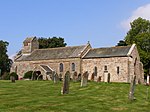Flass

Flass, also called Flass House, is a large Grade II* listed house near the village of Maulds Meaburn, Cumbria, England. It was built in the 19th century in the Neo-Palladian style by the tea and opium traders Lancelot and Wilkinson Dent of Dent & Co. It remained in the hands of the Dent family until 1972, when it was sold to the historian Frank Welsh. It was sold again in 1982 to the solicitor Malcolm Whiteside, who temporarily ran the property as a care home. In 2000, the musician Christine Holmes and her husband Paul Davies bought the property. The pair divorced, and, in 2012, it was discovered that the property had been used by a criminal gang for the cultivation of cannabis. Six men, including Davies, were jailed in 2015. Holmes took control of the property, which was sold at auction in 2019.
Excerpt from the Wikipedia article Flass (License: CC BY-SA 3.0, Authors, Images).Flass
Brackenslack Lane,
Geographical coordinates (GPS) Address Nearby Places Show on map
Geographical coordinates (GPS)
| Latitude | Longitude |
|---|---|
| N 54.535 ° | E -2.5771666666667 ° |
Address
Brackenslack Lane
CA10 3HW , Crosby Ravensworth
England, United Kingdom
Open on Google Maps











